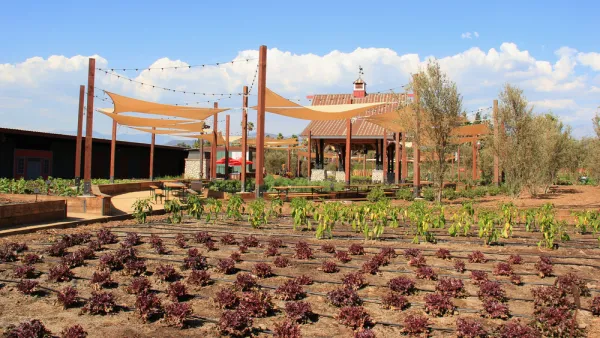With a year-round temperate climate and a history of widespread urban agriculture, it's a shame that Los Angeles now finds itself ranked 43rd amongst America's 50 largest cities for their support of local food. Can L.A. turn back the clock?
The good news, according to Willy Blackmore, is that if Los Angeles devoted just 9 percent of its urban land to crops, it could produce enough food to feed its residents. The bad news, for now, is that with only 6,000 acres of land in L.A. County devoted to growing food, the area is about 63,000 acres short of becoming "a self-sustained urban farming mecca."
Blackmore profiles a group of activists that are trying to turn the bad news into good news by pushing, "the city's agricultural policy further into the 21st century-and into the upper ranks of American cities with progressive urban agriculture agendas."
"'We all want to grow food and we want it to be easy,' says Francesca De la Rosa, co-chair of the Los Angeles Food Policy Council's working group to advocate for urban agriculture policy in the city. That would mean limiting bureaucratic hurdles, clarifying the rules, and extending some base-level incentives to urban agriculturalists-from overhauling the city's free compost and mulch giveaway programs to extending the reduced water-usage rate that big agriculture enjoys for smaller edible landscaping and gardening projects."
According to Blackmore, "Activists are also encouraging L.A. to find farming opportunities in its own backyard-the city's underused public parks, city-owned vacant lands, schools, hospital grounds, green spaces between the sidewalk and the street-even its prison yards. To push the issue, L.A.-based edible landscaping outfit Farmscape has launched a stunt campaign to elect the company mayor under a platform to 'bring farms back to the city.'"
FULL STORY: Lifestyle Growing Pains: Why Is L.A. So Hard on Urban Farmers?

Analysis: Cybertruck Fatality Rate Far Exceeds That of Ford Pinto
The Tesla Cybertruck was recalled seven times last year.

National Parks Layoffs Will Cause Communities to Lose Billions
Thousands of essential park workers were laid off this week, just before the busy spring break season.

Retro-silient?: America’s First “Eco-burb,” The Woodlands Turns 50
A master-planned community north of Houston offers lessons on green infrastructure and resilient design, but falls short of its founder’s lofty affordability and walkability goals.

Test News Post 1
This is a summary

Analysis: Cybertruck Fatality Rate Far Exceeds That of Ford Pinto
The Tesla Cybertruck was recalled seven times last year.

Test News Headline 46
Test for the image on the front page.
Urban Design for Planners 1: Software Tools
This six-course series explores essential urban design concepts using open source software and equips planners with the tools they need to participate fully in the urban design process.
Planning for Universal Design
Learn the tools for implementing Universal Design in planning regulations.
EMC Planning Group, Inc.
Planetizen
Planetizen
Mpact (formerly Rail~Volution)
Great Falls Development Authority, Inc.
HUDs Office of Policy Development and Research
NYU Wagner Graduate School of Public Service


























